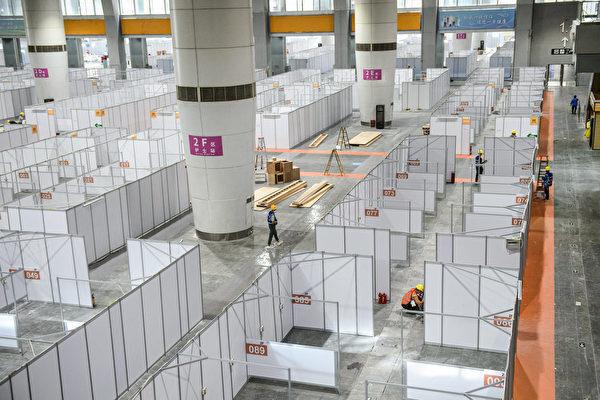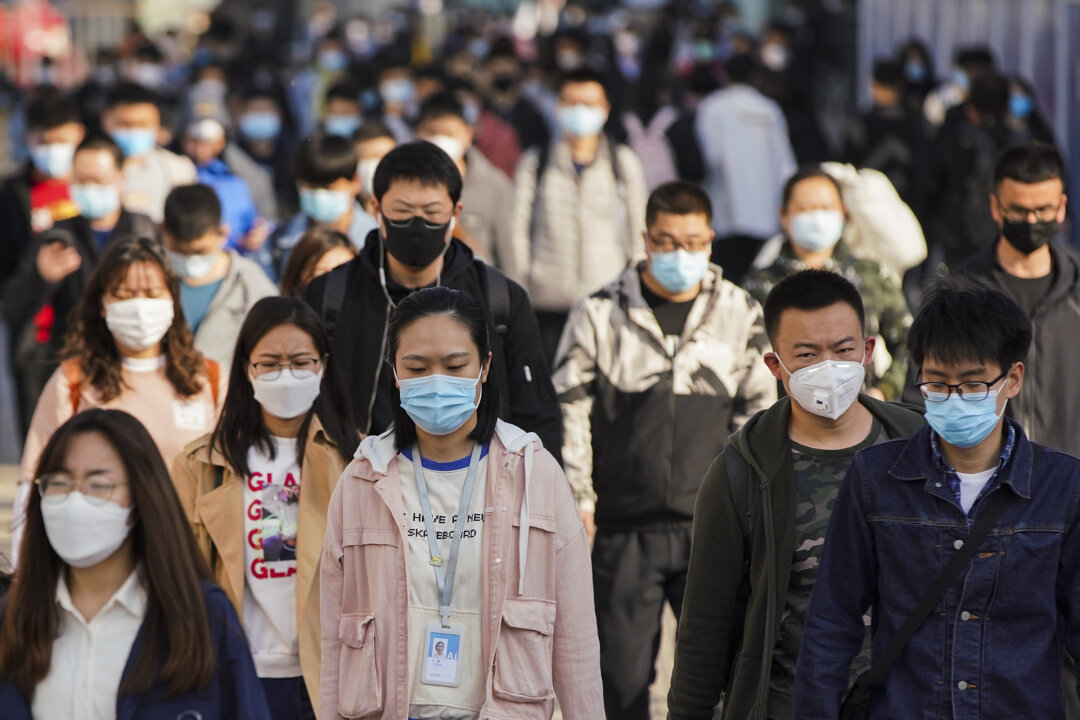The Chinese regime’s ongoing cover-up is endangering the world as it’s not possible to track virus spreading routes, one expert said.
Doctors and residents across China continue to report more infections and deaths as the latest wave of COVID-19 continues, portraying a far more severe situation than the Chinese regime is letting on.
Schools in various provinces are reportedly suspending classes and placing students in quarantine, leading to growing concerns among the public of a return of lockdowns, according to information provided to the Chinese language version of The Epoch Times and on social media.
A “home quarantine notice,” issued by a primary school in Guangzhou and circulated by Chinese netizens on China’s TikTok equivalent, Douyin, before being posted to social media platform X on May 26 before CCP censors could delete it, has attracted widespread attention.
The notice said that a third-grade student was ordered to undergo quarantine for seven days after being diagnosed with COVID-19. After the quarantine period, health certificates from a clinic and community health service agency were required for the student to return to school.
Schools in Shaanxi and Jiangsu also suspended classes after some students exhibited fevers, which were suspected to be COVID-19 infections.
The Chinese communist regime’s official data show that the COVID-19 infection rate doubled in April, with 168,507 cases, including 340 severe cases and nine deaths. The Chinese Center for Disease Control and Prevention (China CDC) said that infection rates in China’s southern provinces were higher than that in the north.
Chinese state media Xinhua reported on May 28 that, according to health officials, the upward trend of COVID-19 infections has slowed down, and in most provinces the epidemic has reached a peak or is on a downward trend.
However, residents across the country told The Epoch Times the situation is far worse and that official data continue to not match their lived experience.
Because of the CCP’s history of covering up information and publishing unreliable data, including the underreporting of COVID-19 infections and related deaths since early 2020, accounts from local medical doctors and residents can offer valuable information for understanding the situation on the ground in the totalitarian country.
Kang Hong, a doctor at a clinic in Guangzhou city in China’s south who used a pseudonym for safety concerns, told The Epoch Times on May 29 that most of those infected with COVID-19 in this wave have been adults, although it has also affected children.
“Their symptoms are far more severe than the common cold,” he said, including the white-lung symptom often seen in COVID-19 patients.
Kang said that most patients came to the clinic for symptoms of colds and fevers. He added that they are not being tested for COVID-19 “because hospitals in China had not conducted large-scale nucleic acid testing for a long time because it was worried about causing social panic.”
Many patients are also unwilling to take a COVID-19 test, Kang said, “because they know they are infected with the COVID-19 (based on their symptoms) and were unwilling to spend more than 100 yuan ($13.90) for testing.”
Kang revealed that a doctor in a tertiary hospital in Guangzhou, where his daughter works, died from COVID-19 in recent days. “It’s a senior doctor who only got tested when his symptoms became serious, and the result was COVID-19,” Kang said.
Kang added that although COVID-19 infections have increased, the local health bureau told the doctors that they do not need to report confirmed cases.
Mr. Li, a resident of Guangzhou city who only gave his last name out of safety concerns, told The Epoch Times that there are many people around him who have had cold-like symptoms recently, including his whole family. Li said they were diagnosed with COVID-19 several times before, and believe their symptoms are another round of COVID-19.
Mr. Guo, a resident in the adjacent Shenzhen city, told The Epoch Times that during the May Day holiday (May 1 to May 4), many people traveled and started to show cold symptoms that are likely COVID-19 afterwards.
Meanwhile, residents in north China also reported a spike in COVID-19 infections.
Liu Kun, the owner of a private clinic in Hohhot city in Inner Mongolia who gave the pseudonym for safety concerns, told The Epoch Times on May 30 that COVID-19 infections are ongoing, “with many experiencing symptoms of coughing, sputum, vomiting and diarrhea.”
He said there are many patients whose “symptoms last for a long time—some even for months.” He predicted that based on the characteristics of this infectious disease, “there may be an explosive growth in infections in June and July.”

Mr. Xu, a resident in Benxi city of Liaoning Province who only gave his surname out of safety concerns, told The Epoch Times that some of his friends and relatives have recently caught colds. “We have already realized that it may be COVID-19 caused by a mutated virus. The symptoms have been dragging on and not getting better. It cannot be cured by medicine at all.”
He added that there have been sudden deaths, especially concentrated around people in their 40s and 50s.
The infections have also been rapidly spreading in Shanxi Province, Mr. Luo, a resident of Changzhi city who only gave his surname, told The Epoch Times. “My family members—including my wife, daughter, son-in-law, and granddaughter—have all been infected,” he said.
Fear of Zero-COVID Restrictions
The school suspensions and quarantines have heightened public concern that the regime’s draconian zero-COVID restrictions employed from 2020 to the end of 2022—during which communities were locked down, mass testing was mandatory, travel was restricted, and residents were forcefully sent to quarantine centers—could make a comeback.
Dr. Jonathan Liu, director of Liu’s Wisdom Healing Centre and a professor at Canada Public College, told The Epoch Times on May 30 that although mainland China is experiencing another wave of COVID-19 infections, the official data hasn’t indicated a serious spread that requires the lockdown of cities.
“Following the continuing strategy of concealment, the Chinese regime does not want to shut down the cities or implement the zero-COVID policy at the moment because that will seriously affect its economic development. Now, stimulating economic development is the regime’s top priority,” Liu said.
Sean Lin, assistant professor in the Biomedical Science Department at Feitian College and former U.S. army microbiologist, shares a similar assessment.
“The authorities won’t immediately adopt the lockdown measure because they also know that if they implement the strict zero-COVID policy, it will cause a huge backlash from the public,” Lin told The Epoch Times on May 30.
“So the government is now building mobile cabin hospitals or temporary isolation facilities in various regions to quietly take people away. There may not be major changes in policy announced to the public,” he said.
The Chinese language edition of The Epoch Times reported earlier this year that, according to insiders in some parts of China, local governments were building large scale mobile cabin hospitals to quarantine patients with respiratory infections, including COVID-19, such as in Urumqi in Xinjiang region and in several provinces.

Lin said that some places may have adopted measures to let people stay at home for quarantine “but it will not turn into a large-scale policy unless the regime is unstable and the authorities have to take such measures. It has not reached that point yet.”
The China CDC has yet to release its COVID-19 data for May but did update its weekly influenza report, in which the number of infections increased significantly this week.
According to the weekly influenza report for epidemiological week 21 (May 19 to 25), released May 29, a total of eight influenza-like outbreaks have been reported nationwide. In comparison, only one influenza-like outbreak was reported nationwide in week 20 and no influenza-like outbreaks were reported in week 19.
Lin said that the authorities continue to cover-up real COVID data in China. “The people do not know the real situation and the severity of the wave of outbreak, especially the severity rate and mortality rate. The authorities don’t tell the people.”
He said that China’s situation is more complicated and severe, as “it involves multiple respiratory pathogens co-circulating and co-infections, with three or four respiratory pathogens infecting at the same time, not just this NB.1.8.1 strain. But the officials have not revealed the real situation, so I think it is difficult for the international community to understand.”
NB.1.8.1
Chinese health authorities announced on May 23 that Omicron variant NB.1.8.1 is currently the primary variant spreading across China, as detection of the variant increased in the international community.
NB.1.8.1 is a sixth-generation sub-branch of the XDV variant.
“The current data does not show that the NB1.8.1 variant has a significant breakthrough in pathogenicity, but it has an almost 1.8-fold improvement in immune escape capability. If it replaces the previous dominant variant that caused COVID-19, it’s because its transmission ability is enhanced,” Lin told The Epoch Times.
He pointed out that new COVID variants have frequently emerged in the past three years. “Often new strains quickly replace old ones to be the dominant one. This has become routine.”

The World Health Organization (WHO) has classified NB1.8.1 as a “variant under monitoring,” which means on “a watchlist,” Lin said. “At present, the international community does not regard this variant as worthy of special attention.”
As the wave of infections in China continues, neighboring Asian countries and the United States have reported COVID-19 cases caused by NB1.8.1, including in international travelers at airports.
However, Lin said there is no sign of a ban of travelers or flights from China by other countries “because the WHO does not have accurate data from China.”
“According to the current monitoring of countries around the world, there has not been a rapid, large-scale increase in infections like in the one in 2020.”
Lin said that because the Chinese regime does not reveal true data, “it’s not possible to track virus spreading routes.”
“This also brings about a greater danger,” he said. “China often covers up many things until they can no longer be covered up. When they come out, the situation is already quite serious and may be out of control. This is actually the biggest concern.”
Luo Ya, Fang Xiao, and Xiong Bin contributed to this report.

